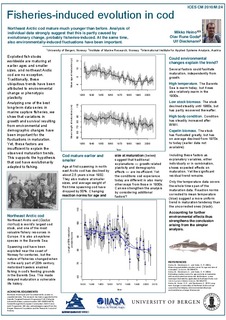| dc.contributor.author | Heino, Mikko | |
| dc.contributor.author | Godø, Olav Rune | |
| dc.contributor.author | Dieckmann, Ulf | |
| dc.date.accessioned | 2012-02-06T14:35:51Z | |
| dc.date.available | 2012-02-06T14:35:51Z | |
| dc.date.issued | 2010 | |
| dc.identifier.citation | This report is not to be quoted without prior consultation with the General Secretary. | no_NO |
| dc.identifier.uri | http://hdl.handle.net/11250/102582 | |
| dc.description.abstract | Over the last eight decades, northeast Arctic cod has shown a marked change towards earlier maturation at smaller sizes. At the same time, harvesting shifted from primarily targeting mature cod in the spawning grounds to targeting a mixture of immature and mature cod in the stock’s feeding grounds. Under such changes in mortality regime, life‐history theory predicts that the stock is expected to evolve towards maturation at smaller sizes. Thus, the observed maturation changes seem to corroborate the theory. However, alternative explanations can be entertained. Earlier maturation is expected when total mortality increases as a direct demographic response. Earlier maturation could also occur as a phenotypically plastic response to changes in the environment (e.g. as a compensatory response when lower stock density allows individuals to grow faster and mature earlier). An analysis of probabilistic reaction norms for age and size at maturation suggests demographic changes and growth‐related phenotypic plasticity contribute to the documented maturation trend, but that they are not sufficient to explain it. This strengthens the support to the hypothesis that cod have adapted to fishing by maturing earlier. However, there can be other important sources of plastic changes in maturation. With the available data, we can account for four additional factors: temperature, body condition, total‐stock biomass, and capelin abundance (the main forage species of northeast Arctic cod). These turn out to show the expected effects on maturation (negative for total‐stock biomass and positive for the others), but nevertheless, a significant trend towards earlier maturation at smaller sizes still remains. Thus, our analysis strongly supports the hypothesis of fishery‐induced maturation evolution in northeast Arctic cod. | |
| dc.language.iso | eng | no_NO |
| dc.publisher | ICES | no_NO |
| dc.relation.ispartofseries | ICES CM documents;2010/M:24 | |
| dc.subject | cod | no_NO |
| dc.subject | torsk | no_NO |
| dc.subject | fisheries induced evolution | no_NO |
| dc.subject | fiskeriindusert evolusjon | no_NO |
| dc.title | Fisheries-induced evolution in cod | no_NO |
| dc.type | Working paper | no_NO |
| dc.subject.nsi | VDP::Agriculture and fishery disciplines: 900::Fisheries science: 920::Resource biology: 921 | no_NO |
| dc.source.pagenumber | 1 s. | no_NO |
